Red for Every Color Season – Find Your Perfect Shade of Red
Red is a standout color that makes a statement in any wardrobe, and embracing the right shade of red for your seasonal color palette can elevate your style to new heights.
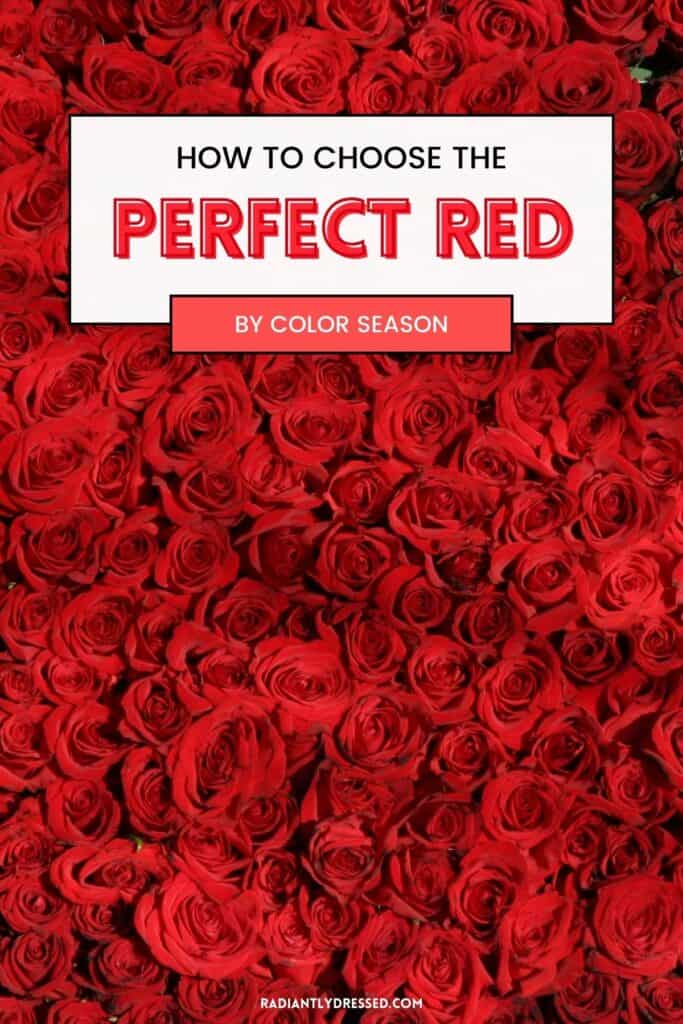
Color analysis has identified specific reds that not only complement the season but also harmonize with your skin tone, eyes, and hair color, ensuring that you can wear this vibrant color confidently year-round.
Understanding your personal color season allows you to choose clothing that flatters and reflects your natural beauty.
If you’re an ‘Autumn’ with a warm, earthy undertone, or a ‘Winter’ with stark contrasts in your features, there’s a spectrum of red shades that are perfect for you.
Whether dressing up for a special occasion or adding a pop of color to your everyday outfit, knowing how to navigate the red palette means you’ll always look put-together and feel your best.
Table of Contents
The Psychology of Red
When you think of the color red, specific emotions and images might instantly come to mind. Red is often seen as the most intense and dynamic of the spectrum, stirring feelings that can be both positive and negative.
- Passion and Love: Red is the quintessential color of love and Valentine’s Day. This association makes you more likely to think of romance and connection when you see a red heart or a bouquet of red roses.
- Energy and Excitement: A color tied to movement and vigor, red can evoke a sense of physical energy, action, and urgency—perfect for capturing your attention and encouraging you to take action.
- Danger and Warning: It’s no coincidence that red is used for stop signs and fire engines. Red has a natural ability to grab your attention, signaling caution or alerting you to potential hazards.
The color red’s impact isn’t just cultural; it has psychological roots that tie back to our primal instincts. This makes red a powerful color to incorporate into your wardrobe regardless of the season. Whether you are choosing an outfit for a winter holiday party or selecting a summer beachwear, red has the ability to make you stand out and tap into a reservoir of emotional responses from those around you.
Understanding Color Seasons
Color seasons are a concept in fashion and beauty that relate to finding the colors that best match your natural features like skin tone, hair color, and eye color. There are 4 major seasons that split into 3 smaller sub seasons each:
- Spring – warm and light with bright contrast: clear spring, warm spring, light spring.
- Summer – cool and light and muted: light summer, cool summer, soft summer.
- Autumn – warm and dark with low contrast: soft autumn, warm autumn, deep autumn.
- Winter – cool and dark with high contrast: deep winter, cool winter, clear winter.
Here’s a quick way to get started in identifying your season:
- Observe your natural skin tone, eye, and hair color.
- Compare these to the typical characteristics of the four seasons.
- Notice how certain colors impact your appearance—do they make you look vibrant or washed out?
Want to find your season? Grab the DIY color analysis course today and find your best colors.
Tired of going round in circles trying to figure out your color season? Hack the same process used by professional color analysts to figure out your season from the comfort of your home, and stop feeling confused about color analysis with Personal Prism.
Now that you know a little more about color seasons, you’re on your way to choosing shades of red that make you look your best!
The Perfect Red for Spring Seasons
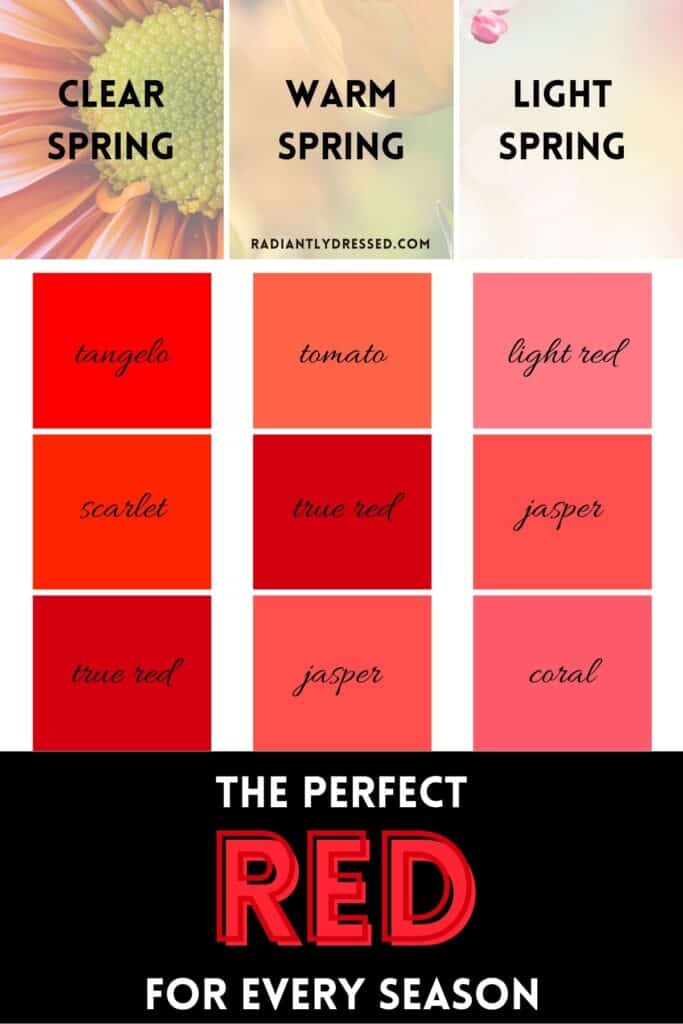
The three spring seasons are warm in undertone, overall light in value, and bright in chroma or saturation. The reds for these seasons need to have those same characteristics. There is some crossover in the reds that work, but slight adjustments can be made for changes in saturation and value.
For clear spring, consider bold, bright, slightly deeper reds such as tangelo, scarlet, and true red.
For warm spring, stick with bright primary reds like tomato, true, red, and jasper.
Light spring needs slightly lighter versions of red, such as light red, jasper, and coral.
The Perfect Red for Summer Seasons
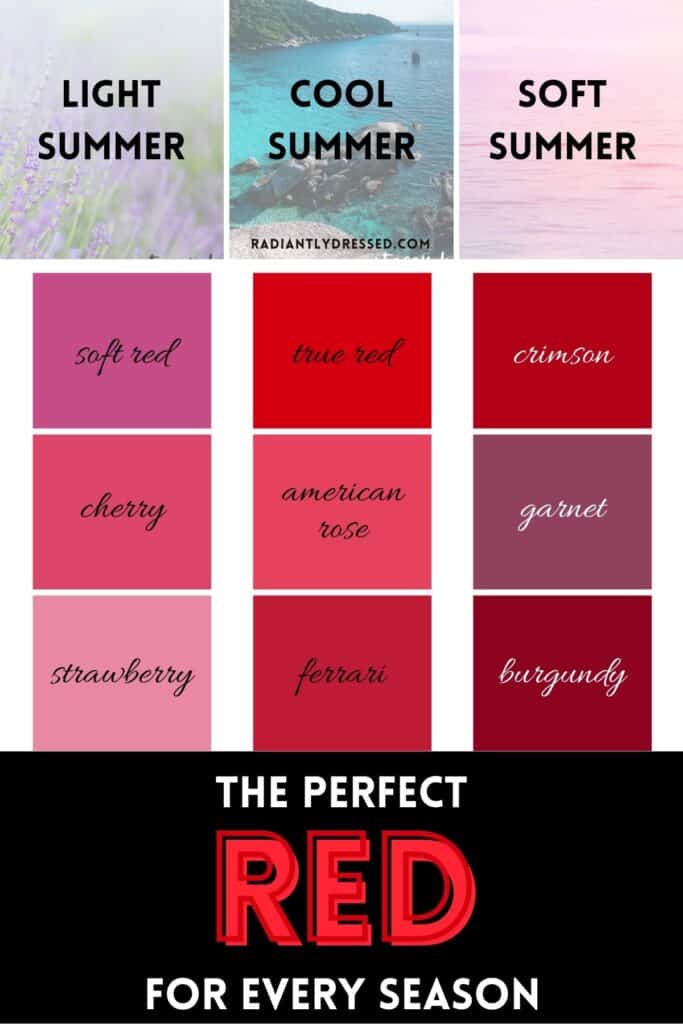
The three summer seasons are cool in undertone, overall light in value, and muted in chroma, not very saturated. Choosing reds with those same characteristics will create a harmonious appearance. These reds will work for all 3 summer seasons, but reflect the variations in intensity and depth.
Light summer will do best in the most pastel versions of red such as soft red, cherry, and strawberry.
Cool summer steals a bit of brightness from its sister season of winter and can wear shades like true red, american rose, and ferrari.
Soft summer sticks with darker muted reds such as crimson, garnet, and burgundy.
The Perfect Red for Autumn Seasons

Autumn types are warm in undertone, overall dark in value, and muted in chroma, with a bit of muddiness to the colors. The three autumn seasons should choose reds that mimic the soft characteristics of this type. You can always borrow from your sister seasons, but the reds for each subseason show slight variations for chroma and value.
For soft autumn, consider muted reds like bittersweet, redwood, and burgundy.
Warm autumn gets a bit of a brightness boost, and reds such as brick red, persimmon, and true red will work great.
Deep autumn is one of the darkest seasons and should stick to shades of red like wine, auburn, and carnelian.
The Perfect Red for Winter Seasons
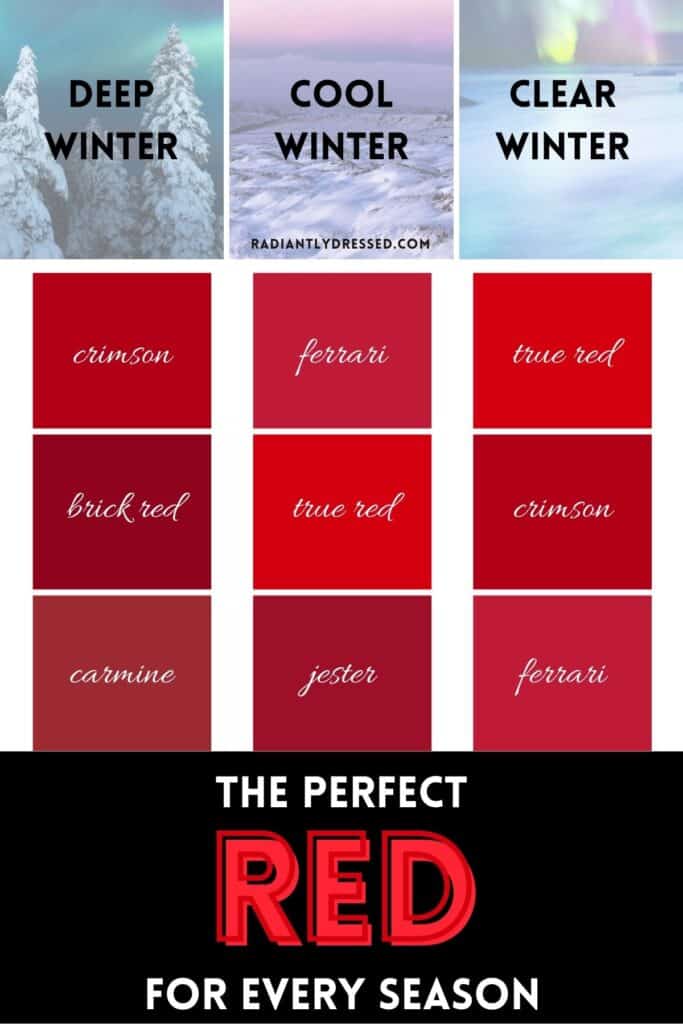
The three winter seasons are cool in undertone, darker in value, and exhibit a high degree of contrast or saturation. The reds for this season are bright, deep blue based shades. The range can be worn by all winters, so choose based on your level of brightness or depth.
Deep winter needs dark reds such as crimson, brick red, and carmine.
Cool winter needs the bold blue reds like ferrari, true red, and jester.
For clear winter, choose the brightest versions of cool red such as true red, crimson, ferrari.
Styling with Red: Seasonal Tips and Accessories
Spring Style Tips: Mixing Patterns with Red
- Balance is Key: Pair a bold red pattern with neutral pieces to balance the look. Try a red floral blouse with beige slacks or a red checked skirt with a crisp white shirt.
- Complementary Colors: Use colors that complement red, such as navy or cream, in your patterns to create a cohesive outfit. A red and navy striped dress can be both classic and spring-appropriate.
- Spring Accessories: Pair your light, airy outfits with playful red scarves or bandanas to add a touch of vibrancy.
Summer Red Outfits
- Tops: A coral tank top paired with white linen pants captures the essence of summer.
- Dresses: Choose a flowy watermelon sundress for a casual day out.
- Accessories: Opt for red sunglasses or a chic hat to keep you cool and stylish. Add a pop of color with a salmon-colored scarf or a coral handbag.
Layering with Red in Autumn
- Classic Cardigan: A red cardigan can act as a statement piece over a simple white tee.
- Accessory Accents: Incorporate red with scarves, hats, or even a bold lip color to add a pop to your ensemble without overwhelming it.
- Outerwear: A red blazer or jacket brings vibrancy to otherwise muted autumn looks. Choose a shade of red that compliments your skin tone for an instant uplift.
- Fall Accessories: Accentuate your layering with a red leather bag or gloves for added warmth and style.
Accessorizing with Red in Winter
- Scarves and Hats: Choose a red beanie or scarf for a cozy and stylish statement.
- Bags: A red leather satchel or clutch can add sophistication to your winter outfits.
- Winter Accessories: A plush red scarf or beanie will add warmth and color to your ensemble. A bold red watch strap or a pair of garnet earrings can make a significant impact without overpowering your overall look.
General Accessorizing with Red
- Pairing with Patterns: If your outfit features a pattern, pull a red hue from it for your accessories. This creates a harmonious look.
- Balancing the Brightness: To balance the intensity of red, use it alongside neutral garments, like light wash denim.
- Mixing and Matching: Don’t hesitate to mix red accessories with other colors. For example, a red belt can look stunning when paired with a pink dress, creating an on-trend, color-blocking effect.
Maintaining Red Clothing
When you buy a vibrant red garment, keeping its color as brilliant as the day you bought it is essential. To ensure this, always read the care label before washing. Different fabrics require specific care, so it’s crucial to follow the instructions provided.
Here are some tips to help you keep your red clothing looking its best:
- Sort your laundry: Always wash red items with similar colors, especially the first few times, as red fabric can bleed.
- Cold water cycle: Use cold water to prevent the red dye from running and to protect the fabric.
- Mild detergent: Opt for a mild detergent and avoid bleach, as it can strip away the color.
- Turn clothes inside out: Avoid direct contact with the drum or agitator by turning red items inside out before washing.
- Air-dry when possible: Heat can fade reds, so air-dry your clothes away from direct sunlight.
In summary, gentle care is the key to maintaining your red clothing.
Handle them with love, and they will stay bold and beautiful for seasons to come.
Incorporating Red at Work
Adding a pop of red to your work wardrobe can be a delightful way to inject energy and confidence into your professional attire.
When dressing for work, it’s important to balance boldness with appropriateness.
Here are some tips for incorporating red into your office outfits:
A Statement Blazer:
- Grab a red blazer to pair with neutral basics.
- Keep the cut professional, opting for fitted silhouettes, such as a cropped flap blazer.
Tops and Shirts:
- A crisp red blouse or a sleeveless pleated top can brighten up your look.
- To avoid overpowering, wear with tailored trousers or a simple pencil skirt.
Accessorizing:
- Incorporate red subtly with accessories like a belt, scarf, or a pair of earrings.
- A garnet-colored watch or bracelet adds sophistication.
Bottoms:
- Dare with Care: Red trousers can be office-appropriate if the tone is muted.
- Balance with a white or black blazer for a clean, modern ensemble.
Shoes:
- Red shoes can transform an outfit.
- Stick with classic styles like pumps or loafers for professionalism.
Red for Special Occasions
When you’re dressing up for a special event, red is a powerful color choice that conveys confidence and style.
Regardless of the season, incorporating red into your attire can make a bold statement.
Formal Events:
- For gala dinners or sophisticated parties, a red gown or cocktail dress in the right shade can be stunning.
- Choose a deep burgundy for winter, while a brighter cherry or scarlet red is perfect for summer soirées.
Weddings:
- If you’re a guest at a wedding, opt for a tasteful red dress or suit.
- Keep it elegant with minimal accessories to let the red be the centerpiece of your outfit. However, be mindful of cultural sensitivities, as red can have different connotations around the world.
Holiday Parties:
- During the holiday season, red outfits are festive and joyful.
- A well-tailored red blazer or a velvet dress brings warmth and cheer to any holiday event.
Accessories:
- Complement your red attire with neutral-toned accessories to balance your look.
- For a pop of red, consider a statement red handbag or shoes.
Frequently Asked Questions about How to Wear Red
Red is a powerfully evocative color that suits a wide range of skin tones and seasons. These FAQs will help you select the perfect shade of red for your color season, ensuring that you look your best no matter the time of year.
Can I wear red if I have a more muted personal style?
Absolutely! Even if your style is more understated, you can still incorporate red into your wardrobe. Opt for deeper, muted shades like burgundy or brick red, or use red accessories to add a subtle pop of color without overwhelming your look.
Is it possible to wear red all year round?
Yes, red can be worn year-round by selecting the right shade and fabric for each season. For example, opt for lighter, brighter reds in spring and summer, and richer, deeper reds in autumn and winter.
How can I incorporate red into my professional wardrobe?
Incorporating red into your professional wardrobe can be done tastefully with key pieces like a red blazer, a red pencil skirt, or a red blouse. Pair these items with neutral colors like black, white, or navy to maintain a professional look.
What makeup should I wear with red clothing?
When wearing red clothing, it’s best to keep your makeup balanced. A classic red lip can work well, but if you prefer a more subtle look, opt for neutral tones on your lips and a hint of red on your nails or as a blush.
Can men also follow these color season guidelines for wearing red?
Yes, men can benefit from color analysis and choosing the right shade of red based on their seasonal color palette. For example, a warm-toned man might look great in a brick red sweater, while a cool-toned man might prefer a deep burgundy tie.
How do I transition my red wardrobe pieces between different seasons?
To transition red pieces between seasons, focus on layering and fabric choice. For example, a lightweight red dress can be worn alone in summer and layered with a cardigan and tights in autumn. Similarly, red accessories like scarves and hats can be used year-round.
What should I avoid when wearing red?
Avoid wearing red if it clashes with your skin tone or if it makes you feel uncomfortable. Also, be mindful of the setting; in some professional or formal environments, a very bright red might be too bold. Opt for deeper or more subdued shades in such contexts.
How can I find my perfect shade of red if I’m still unsure?
Consider professional color analysis to help you determine your seasonal palette and perfect shades. Alternatively, you can experiment with different reds in natural light to see which ones complement your complexion best.
What shades of red work well across all seasons?
True red, a balanced red without too much yellow or blue, can be quite universal. Watermelon red is considered to be a universally flattering color.
Additionally, burgundy and wine reds can work for almost everyone, thanks to their moderate depth and richness.
Related Color and Style Articles:
- Overcoming the Need to Fit In
- 4 Tips to Create a Cohesive Closet
- How to Declutter Your Clothes Using Color
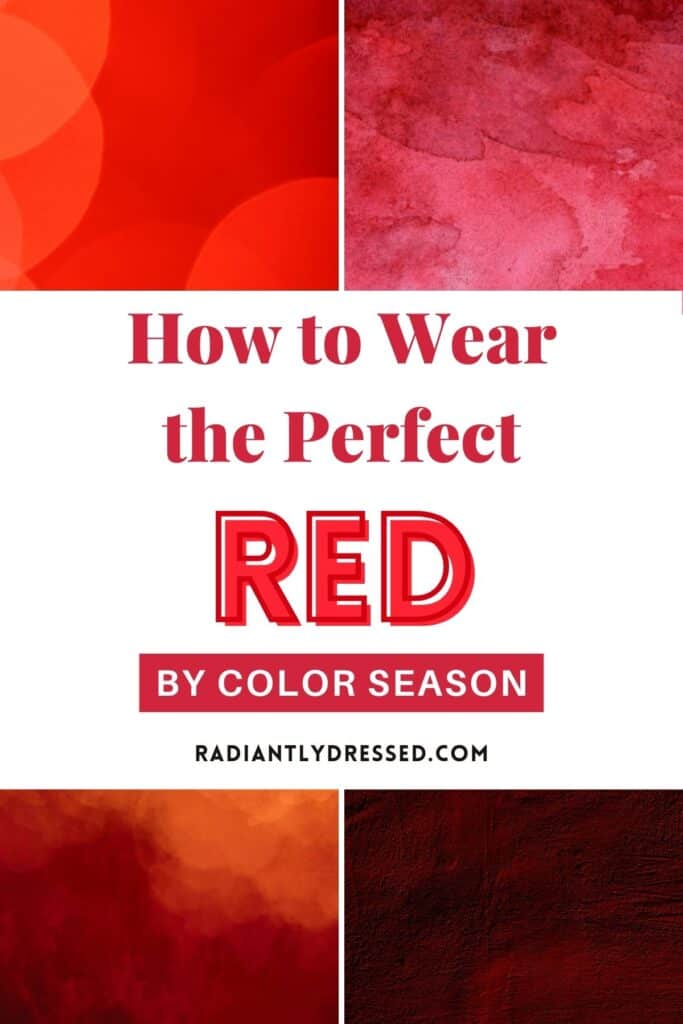
Whether it’s the fiery tones of poppy red in spring or the rich, warm hues of mars red in autumn, there’s a shade of red for everyone.
Stacey is the owner and creator behind Radiantly Dressed. She is a certified image consultant and AICI member focusing on creating simplicity in wardrobes via color and style.



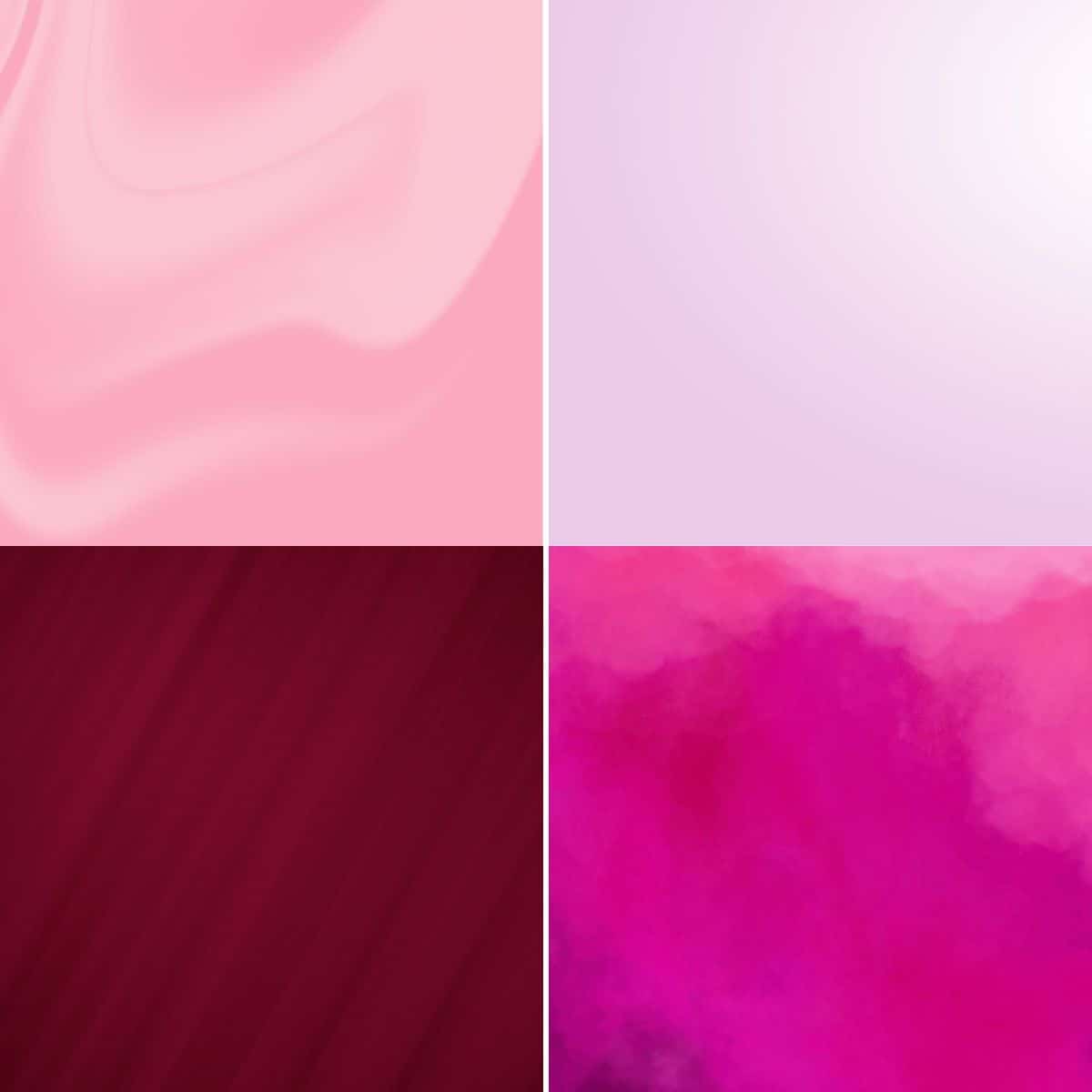
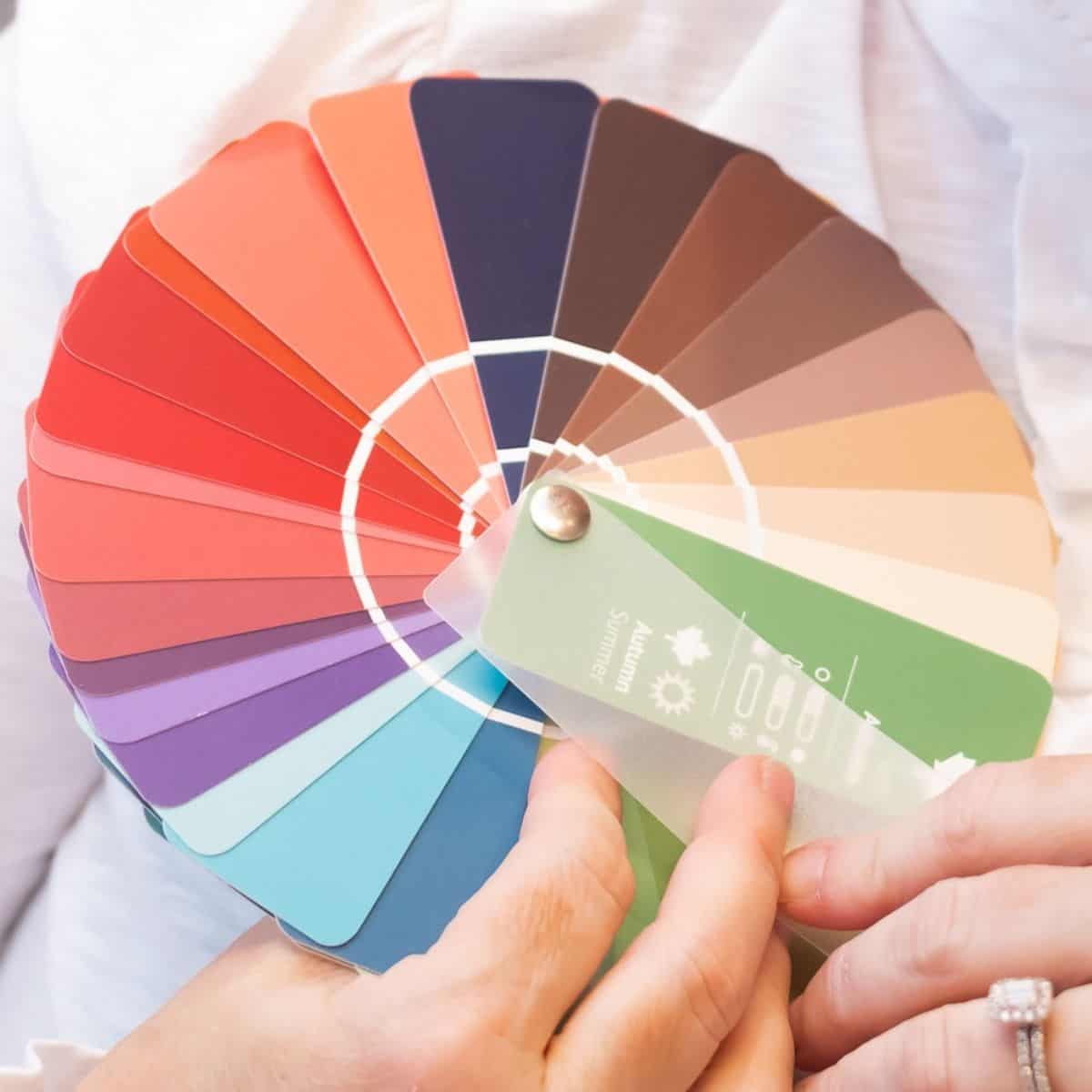
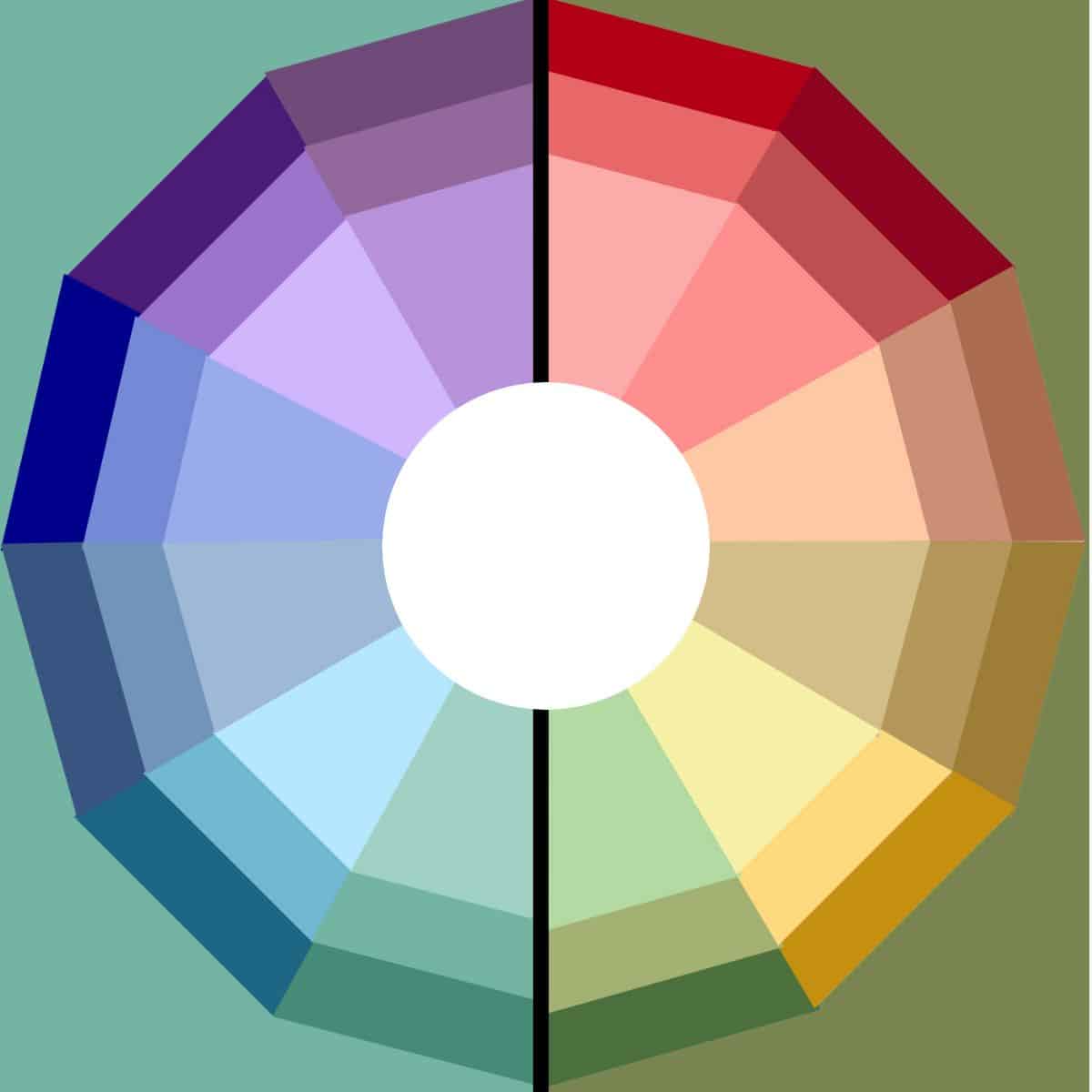

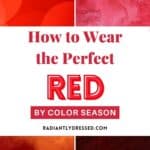

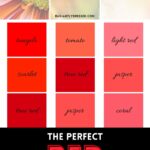
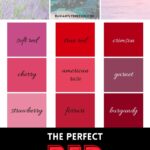

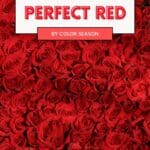
Hey Stacey, first of all – thanks for great article! How would you recommend to style a bordeaux sports-ey shoes with some addition of white? Thanks in advance!